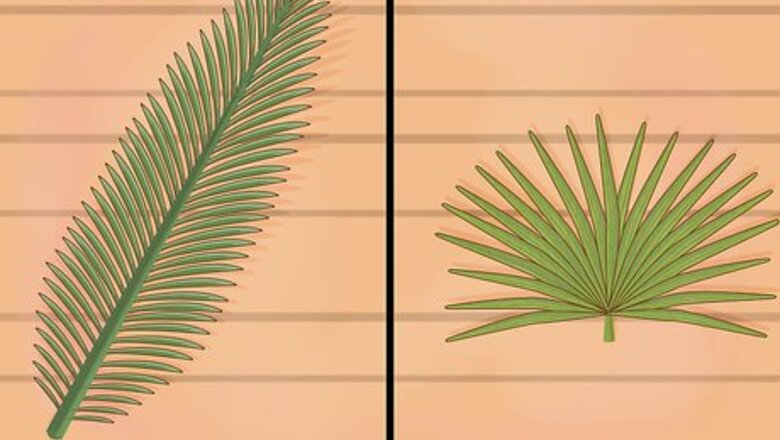
views
Determining a Palm Tree from Other Trees
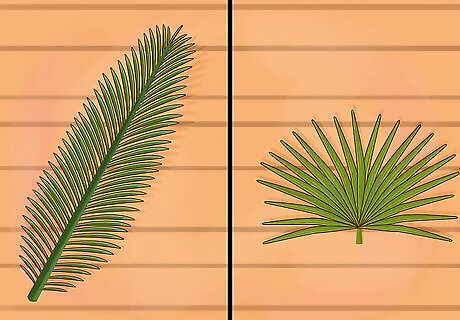
Examine the shape of the fronds, or leaves. Palm trees have very distinct fronds, making them the best way to determine if you’re looking at a palm or another type of tree. Palm fronds range from green or blue-green to silver and fall into 1 of 3 categories: pinnate (feather-shaped), palmate (fan-shaped), and entire (simple). Find descriptions of these categories and their subcategories below: Pinnate fronds have long, separate leaflets that grow the central stalk. Some of the most popular and common palm tree types like the Areca Palm, Coconut Palm, Queen Palm, and Date Palm have pinnate fronds. Palmate fronds extend from the stem, fanning out like the fingers on your hand. Some common palm trees with palmate fronds include the Bismarck Palm, Mexican Fan Palm, and Windmill Palm. Costapalmate fronds are a subcategory of palmate fronds and appear to be a blend of palmate and pinnate. The leaf segments branch out from a short midrib rather than a center point, and they often have folds or sharp twists at their tips. Some examples include the Blue Latan Palm, Red Latan Palm Fiji Fan Palm, and Chinese Fan Palm. Bi-pinnate fronds have a secondary leaf stem attached to the primary one, and the leaflets connect at regular intervals. The Fishtail Palm (or Caryota) is the only type of palm tree with these fronds. Entire, or simple, fronds are composed of a single blade that isn’t separated into smaller leaflets. The Joey Palm and Miniature Fishtail Palm are 2 examples.
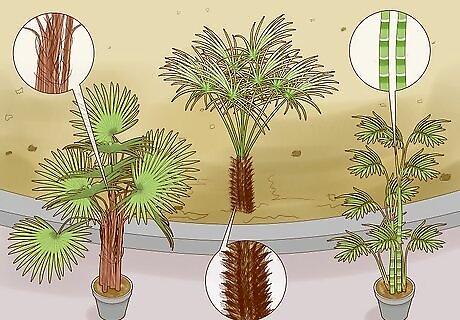
Determine if the tree has a single trunk or a multi-trunk. Palms have either a solitary or multi-trunk, which appears like a cluster of trunks woven together. Typically multi-trunk palms are shorter and have a longer maturation period. Common multi-trunk varieties are the Needle Palm, Lady Palm, and Areca Palm. These often look more like shrubs than tall, slender trees. Coconut or Date Palms are single trunk and much taller than the shorter, shrub variety. The surface of these trunks vary, too. Some are smooth whereas others have leaf bases layered in a criss-cross pattern. Most palm trees have straight trunks but other common varieties like the Coconut Palm have tapered trunks. Some palm trees also have a crownshaft, which is a lengthened leaf base. Crownshafts can be a different color from the rest of the trunk. For example, the King Palm has a rosy purple crownshaft. A few palms have very unique trunk shapes and textures. For example, the Ponytail Palm has a swollen trunk that acts as a water reservoir, while the Old Man Palm’s trunk is covered in hairy-looking fibers.
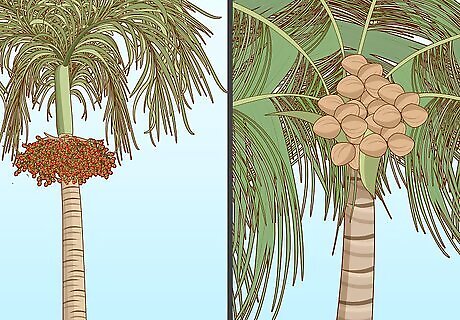
Examine the tree for fruit. Palm trees are most commonly associated with coconuts, but they bear other fruits, as well. Coconuts, acai berries, dates, and betel nuts all come from palm trees, so if you find any of these fruits, you’ve found a palm tree.
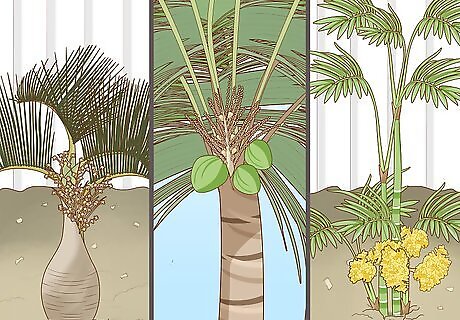
Look for small green or yellow flowers. Palm trees are distinguished by very discreet flowers that are usually yellowish-green to light green, though they can come in many colors. The flowers generally grow in clusters along the stems and are not very vibrant or flashy. Some common distinguishable flowers include the Areca Palm with bright yellow flowers, the Bottle Palm with small white flowers, and the Coconut Palm with sweet-scented yellow flowers.
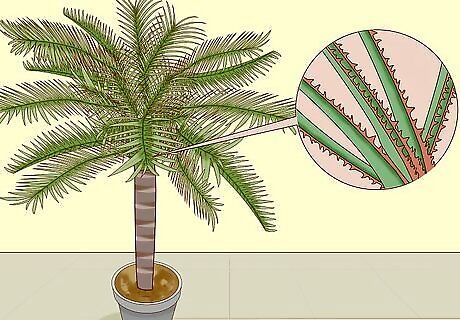
Identify a palm by its leaf stems. One thing that distinguishes a palm tree from other tree varieties is its unbranched stem with leaf tufts either on the end or on each side of the stem known as fronds. These bushy, often large, leaves on the stem are a common identifier.
Determining the Palm Tree Species
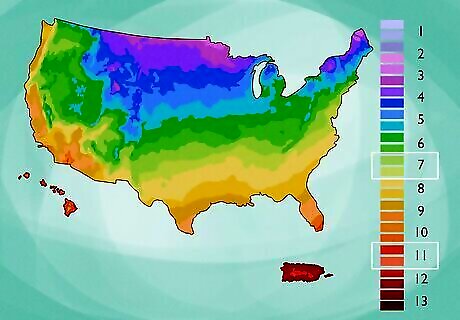
Check the USDA hardiness zone for your area. The United States Department of Agriculture (USDA) divides the country into different hardiness zones based on the temperatures and weather conditions in which vegetation is likely to thrive. Compare the characteristics of the palm with the descriptions of the palms that can be grown in your zone. Some palms will only thrive in Zone 11, while some can be grown as far north as Zone 7. Zone 11 is the most tropical zone in the U.S. and includes the Florida Keys and most of Hawaii’s Big Island. Zone 7 contains southern Oklahoma, northern Texas, and parts of Utah, Arizona, Nevada, and California.
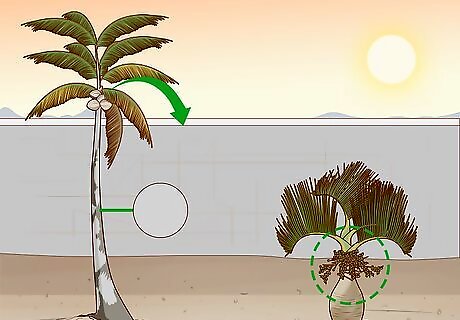
Look for distinguishing features like drooping fronds or bright vivid fruit. There are over 2000 types of palm trees, so it's important to first look for anything that may distinguish one variety from another. Once you’ve determined you have a palm tree, use the same characteristics to further determine the species. For example, if the palm has a thin, narrow trunk, you know it can’t be a Bottle Palm because the trunk shapes don’t match. If it grows coconuts, though, you’ll know it’s a Coconut Palm.
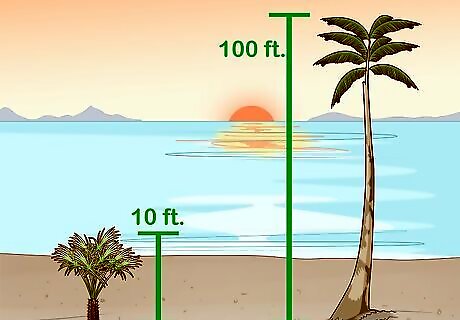
Estimate the tree's size. Once you've narrowed down other distinguishing marks like the fronds and trunk, use the size of the tree to further narrow down the possibilities. Some dwarf varieties only reach 10 feet (3.0 m) while other palms can grow as large as 100 feet (30 m). To distinguish one variety from another, you must examine a mature tree. When palm trees are only a few months old they all virtually look the same. For example, a Royal Palm can grow up to 70 feet (21 meters) while a Lady Palm usually only grows to about 10 feet (3 meters). Tall palm trees generally grow at a quicker pace than short ones. Note that some palms that grow tall naturally may reach much shorter heights when planted in a pot. When trying to determine a palm by height, it’s best to examine those that grow outdoors.
Common Types of Palm Trees
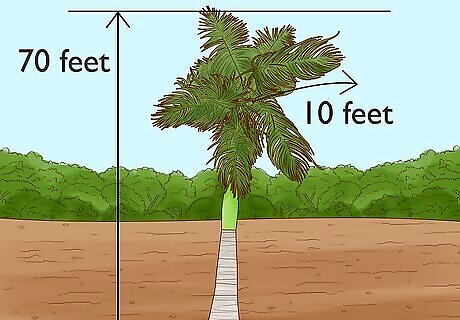
Royal Palms Royal Palms grow relatively quickly to heights up to 70 feet (21 meters). Their trunks are singular, gray, and marked with the scars of old fronds. The fronds are pinnate, dark green, and may be as long as 10 feet (3 meters).
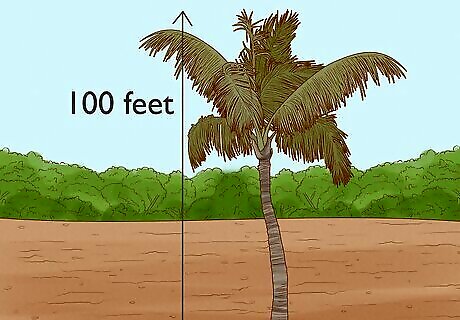
Coconut Palms Coconut Palms have single gray trunks and long pinnate leaves, but they are most distinguishable for growing coconuts, which they do all year long for up to 80 years. Wild coconut palms may grow up to 100 feet (30 meters) tall, but they are much shorter when cultivated, typically growing 5-10 feet tall.
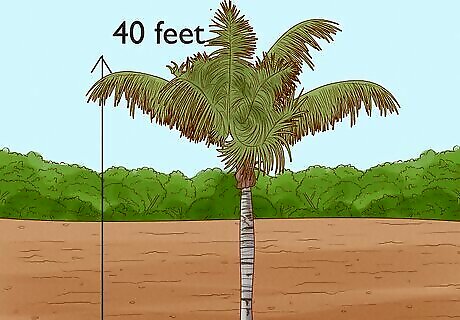
Queen Palms Queen Palms grow as much as 6 feet (2 meters) a year to a maximum height of 40 feet (12 meters). Their trunks are singular, gray, and smooth with scars of old fronds. The fronds are dark green and pinnate, with doubled leaflets.
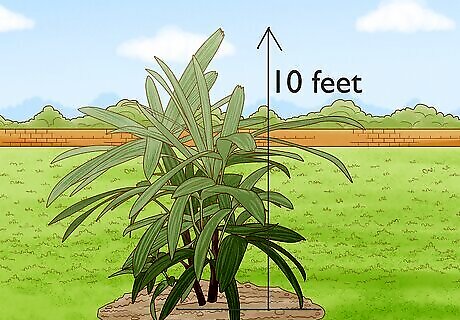
Lady Palms Lady Palms grow slowly to heights of 10 feet (3 meters) outdoors. They may be as wide as they are tall because they often have multiple trunks. They have bright green or dark green palmate fronds, but the fronds are deeply divided, making them look almost pinnate. The petioles have no thorns.
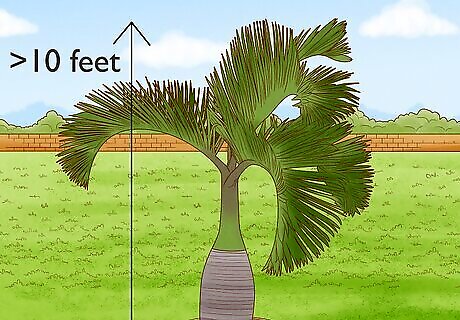
Bottle Palms Bottle Palms, or Dwarf Palms, are so named because of their bottle-shaped trunks covered with the ends of old fronds. They seldom grow taller than 10 feet (3 meters) and are often grown in pots. Bottle palms have pinnate leaves.

Carpentaria Palms Carpentaria Palms consist of pinnate leaves atop a slender gray trunk marked with scars of old fronds. They are most distinguishable by the bright red fruits that grow in clusters beginning when the palm is about 6 years old.

Chinese Fan Palms Chinese Fan Palms, or Fountain Palms, are known for the drooping ends of palmate fronds. They have short, fat trunks that are gray and marked with scars of old fronds. The petioles are thorny and the fronds range in color from blue-green to olive green. Fronds may be up to 5 feet (1.5 meters) wide.


















Comments
0 comment